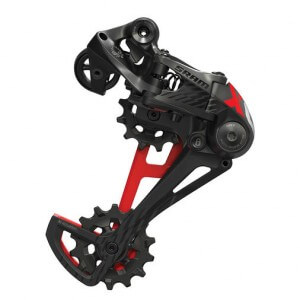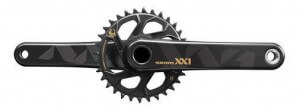SRAM XX1 Eagle & SRAM X01 Eagle 1×12 Drivetrains
 The Eagle has landed! Well, not really, more like it has been announced. On March 24, 2016, SRAM announced two new mountain bike drivetrain groups, a new XX1 for cross country riders and X01 for trail riders, dubbed SRAM XX1 Eagle & SRAM X01 Eagle. The most significant features of these two new 1X drivetrains are a 12 speed cassette, the largest cog having 50, count ’em 50, teeth! Think about that for a second: a rear cassette cog that is the same size as the largest chainring on a compact road double crankset…
The Eagle has landed! Well, not really, more like it has been announced. On March 24, 2016, SRAM announced two new mountain bike drivetrain groups, a new XX1 for cross country riders and X01 for trail riders, dubbed SRAM XX1 Eagle & SRAM X01 Eagle. The most significant features of these two new 1X drivetrains are a 12 speed cassette, the largest cog having 50, count ’em 50, teeth! Think about that for a second: a rear cassette cog that is the same size as the largest chainring on a compact road double crankset…
As a little background, SRAM has been aggressively encouraging 1X mountain bike drivetrains, for some very good reasons. 1X systems do away with a double, or triple, crankset and front derailleur. Therefore, they are lighter and less complicated. Any front derailleur, regardless of how expertly it is adjusted, can result in a dropped chain under the right, or perhaps I should say wrong, circumstances – usually when climbing under power and trying to shift to the small chainring. Most inconvenient. Devices can be added to the bike to guard against derailment of the chain, but they add weight, and if the chain still insists on jumping, these devices can make getting the chain back on quite difficult. Eliminating the front derailleur of course eliminates this problem. According to SRAM, they are no longer devoting any time to development of new mountain bike double chainring components; SRAM strongly feels that the future belongs to 1X’s.
For all their benefits, 1X systems have had a significant drawback: limited gearing range. In choosing the size of the front chainring, some riders had to decide whether to sacrifice their low-end climbing gears, their high end top speed gears or both. One chainring simply could not do it all,  at least until now.
at least until now.
To get a wider range of gearing requires either a cog smaller than 10 teeth which, for all intents and purposes is impossible with current compatibility, or a cog larger than a 42. Hence the idea for a 50 tooth cassette, in combination with a larger front chainring, to gain higher gears without losing the lowest climbing gear ratio in the process. Viola, more low gearing and more high gearing. SRAM also realized that as they made the cassette bigger, the jumps between gears would grow as well and thus they added a twelfth cog. SRAM’s new 1x system has identical gearing to their 10-42 11 speed cassette, but adds the 50 on the low end. The cassette cogs on the SRAM 10-50 cassette are 10, 12, 14, 16, 18, 21, 24, 28, 32, 36, 42 and 50 teeth. That is huge range for a cassette to cover, the top gearing being approximately 500% greater than the lowest. Typical double chainring groups offer a range of about 515%, so this new design will give the rider practically the same range of gearing as a double chainring drivetrain, without the weight, complexity and potential nuisance value of a double chainring set-up.
Of course going to a 12 speed cassette, and one with a 50 tooth cog, requires a complete redesign of the shifter and derailleur. The 12 speed cassette will fit on SRAM’s XD freehub body with the 10 tooth cog in the same location as it is on the 11 speed cassette. The spacing between cogs has been reduced, from 3.8 mm to 3.65 mm, and the 50 tooth cog cups the drive body more, thus bringing it closer to the spokes. According to SRAM, the cassette is compatible with any frame that can handle an 11 tooth cogs. However, it would not surprise me if the positioning of the 50 tooth cog causes interference problems with some wheels on bikes with a 142 mm rear end. We will have to gain more experience with different wheels and the new system before knowing if there are any issues for sure though. For Boost, with 148mm rear spacing, we see little compatibility risk with the new SRAM 1×12 Eagle systems.
Outside of the cassette, other components in the drivetrain had to be redesigned as well on the new SRAM XX1 & X01 Eagle components. A new derailleur had to be produced to deal with that large 50 tooth cog, narrower cog spacing, and the stresses of getting the chain onto that 50 tooth cog smoothly. This was accomplished via new pulleys, cages and roller bearings. The shifter had to be redesigned to provide for 12 clicks and to incorporate revised cable pull to deal with the narrower cog spacing. The new shifter will be available in eit her trigger or Grip Shift varieties. A new chain was required as the width had to be dropped from 5.6mm to 5.25mm to allow for the additional cog. There are many, many design changes to the chain, so that it is now stronger, quieter, and will shift smoother than any previous SRAM chain, even when negotiation that 42 to 50 tooth jump and when managing the more extreme chainline angles a 12 speed cassette creates. The cranks have been redesigned with the SRAM XX1 Eagle crank now being hollow to minimize weight and the more endure oriented X01 featuring a foam core to enhance strength with a minimal weight penalty. When it comes to chainrings, 30, 32, 34, 36 and 38 teeth chainrings are all available and each is specific to the SRAM Eagle design.
her trigger or Grip Shift varieties. A new chain was required as the width had to be dropped from 5.6mm to 5.25mm to allow for the additional cog. There are many, many design changes to the chain, so that it is now stronger, quieter, and will shift smoother than any previous SRAM chain, even when negotiation that 42 to 50 tooth jump and when managing the more extreme chainline angles a 12 speed cassette creates. The cranks have been redesigned with the SRAM XX1 Eagle crank now being hollow to minimize weight and the more endure oriented X01 featuring a foam core to enhance strength with a minimal weight penalty. When it comes to chainrings, 30, 32, 34, 36 and 38 teeth chainrings are all available and each is specific to the SRAM Eagle design.  Just how much redesign occurred? According to SRAM , the only component from the new Eagle drivetrains that could be used with the existing 11 speed 1X systems is the chain.
Just how much redesign occurred? According to SRAM , the only component from the new Eagle drivetrains that could be used with the existing 11 speed 1X systems is the chain.
The drivetrain packages for SRAM XX1 and X01 Eagle includes the cassette, derailleur, crank, chain, and shifters. Pricing for the XX1 package is $1,417, and the X01 costs $1,193. I emphasize the word “package”, for that is how SRAM designed the Eagle drivetrains, and the lack of compatibility with the existing 11 speed systems emphasizes this. For the SRAM Eagle drivetrain system to work well, it should be kept complete.
The move to a 12 speed cassette, and a huge largest cog, addresses the complaints and questions about 1X drivetrains. The SRAM Eagle drivetrains are not yet available and the unofficial word is that these components will be available in either June or July. If you are looking to upgrade the components on your mountain bike to a 1X system, or looking to build up a new mountain bike frame, the new SRAM Eagle XX1 or X01 packages offer some compelling features and helps overcome the biggest reservation some riders have with going 1x. Questions? Want to order? Contact us or give us a call.

